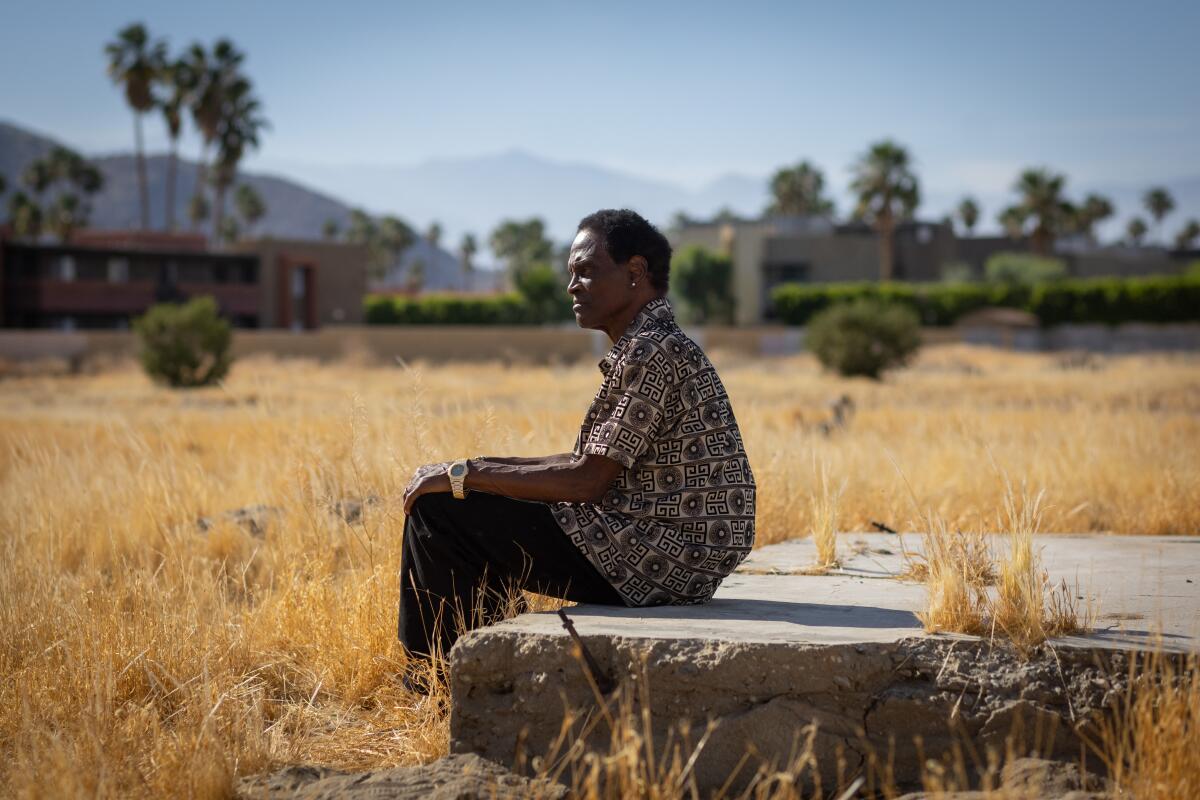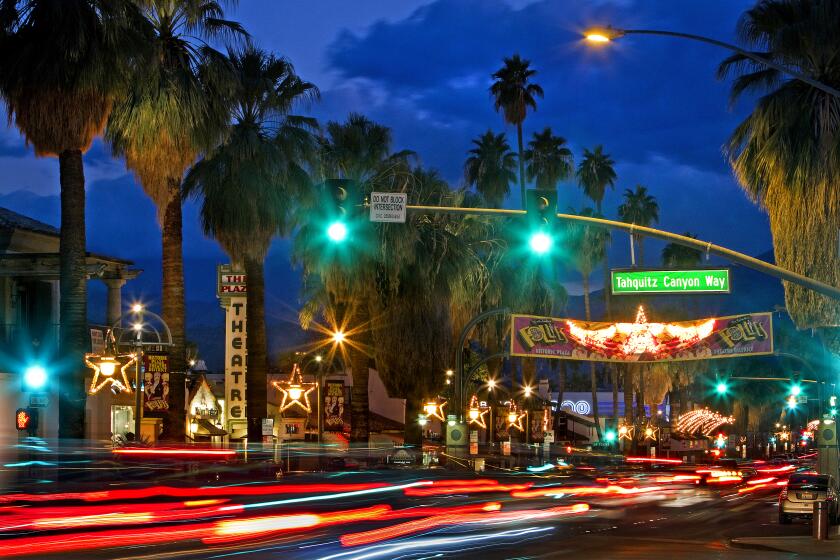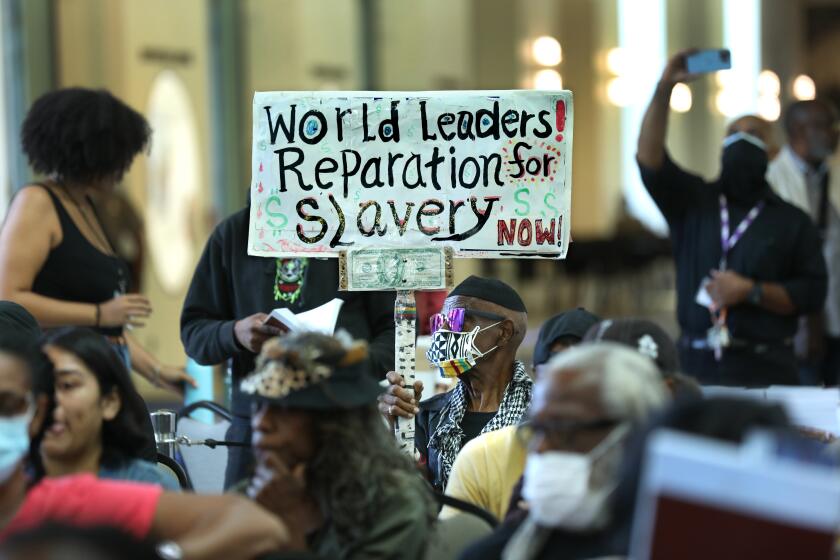Editorial: Palm Springs brutally displaced hundreds. They’re finally getting a measure of justice

- Share via
They were children when their families’ Palm Springs homes were bulldozed and burned as part of the systematic destruction of a community. Now they’re in their 60s or older, and their loss is finally being acknowledged.
The mostly Black and Latino families affected had found a haven on a 1-square-mile tract of land known as Section 14. Located adjacent to downtown Palm Springs, the land is owned by the Agua Caliente Band of Cahuilla Indians, but the federal government had forbidden them to lease it long-term. Instead, from the 1930s into the 1960s, the tribe rented parcels to people with few housing options, particularly Black and Latino residents who worked in the city as housekeepers, carpenters, gardeners and more but were prevented from living in most of Palm Springs by discriminatory housing practices.
Utilities were meager in Section 14, and residents often built their own modest homes. Though they didn’t own the land underneath, they created a community.
Until it was ripped out from under them. What the city characterized as “slum clearance” in the 1950s and ’60s forced residents to flee their homes on just weeks’ or days’ notice or sometimes none at all. A 1968 state report called it “a city-engineered holocaust.”
The city of Palm Springs threw out hundreds of its Black residents in the 1960s and burned down their homes. The shameful chapter should be remembered and the families compensated.
Now, decades later, the city of Palm Springs has offered hundreds of survivors a settlement of $5.9 million. Although it comes late for the surviving victims, who now range from their 60s into their 90s, the recognition that they were traumatized and their homes were burned down, often with their possessions inside, is just.
And it’s particularly commendable at a time when making amends for past racial injustices is hardly in vogue. Gone is the overdue national soul-searching after the 2020 murder of George Floyd by a police officer, which sparked efforts to diversify workplaces and the entertainment industry and apologies for past racist wrongs — including one from the Los Angeles Times.
In 2022, Los Angeles County officials returned a Manhattan Beach property known as Bruce’s Beach to the family of the Black couple run off the land nearly a century earlier. But an ambitious California task force on reparations for slavery went on to meet a tepid response in the state Legislature.
Educating Californians on the state’s role in slavery and institutionalized racism — and why there should be a price literally to pay for it — will be part of the challenge lawmakers face as they work to design a plan for reparations.
So it is noteworthy that the city of Palm Springs has stepped up as few cities in the nation have. Even the last two known survivors of the horrific Tulsa Race Massacre of 1921, now both more than 100 years old, saw their case for reparations rejected by the Oklahoma Supreme Court this year.
Like Tulsa, the Palm Springs case concerns people who lost homes and possessions in living memory. An estimated 300 to 350 survivors of Section 14 may come forward with proof of residency there.
This was a long battle. Survivors and descendants formed a nonprofit and have been advocating for reparations for years. Areva Martin, their attorney, took up the case in 2022, publicizing the plight of the displaced residents and bringing a claim against the city. Officials decided to settle the case.
“Cash restitution is incredibly difficult,” Martin said. “That’s what makes this so historic. There aren’t many examples.”
Martin noted that although her clients never owned the land, their claim was always about the “destruction of their structures and the contents inside the structures.”
Additionally, as part of the settlement’s broader initiatives, the city agreed to designate $20 million for housing programs to assist first-time home buyers in Palm Springs and to establish a community land trust for low-income residents, giving priority to former residents of Section 14 and their descendants. Also, $1 million will be set aside for grants and low-interest loans to help small businesses in disadvantaged communities, with dedicated outreach to former residents of Section 14 and their descendants. And the council agreed to recognize a day of remembrance of Section 14 residents’ contributions to Palm Springs.
The city issued an apology to the survivors three years ago. The settlement is about more than money to some of them.
“It’s a victory in the sense that our history will be cemented,” said Pearl Devers, 74, who leads the board of directors of the survivors nonprofit.
The money comes late in life for most survivors, so the city should ensure that its disbursement is relatively swift. The nonprofit survivors group, aided by experts, will determine how it is awarded. Their attorney says no one should assume it will be evenly divided among former residents, which would amount to less than $20,000 each.
Is it enough to compensate for the malicious destruction of the homes and belongings of hundreds of people?
“There is no amount of money that can ever pay for the damage,” said Alvin Taylor, 71, Devers’ brother. “I can just say that making an effort ... is a step forward. Even if it might not fully address the historical impact of what took place.
“It says, ‘We truly apologize.’ ”
More to Read
A cure for the common opinion
Get thought-provoking perspectives with our weekly newsletter.
You may occasionally receive promotional content from the Los Angeles Times.












